
|
|

May 5, 2006
Remembering WJDA, Quincy and WESX, Salem, Mass.
By SCOTT FYBUSH
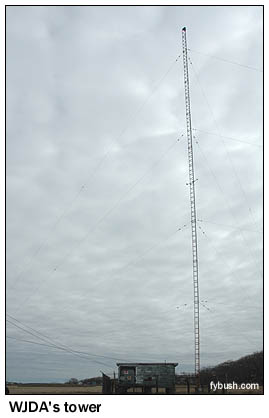 Our
recap of the 2005 "Big Trip" is over - and now it's
time to return to some more familiar soil. We've spent a lot
of time listening to Boston radio stations and visiting their
facilities, but somehow we never managed to pay a call on a pair
of venerable locally-owned suburban AM signals until it was almost
too late.
Our
recap of the 2005 "Big Trip" is over - and now it's
time to return to some more familiar soil. We've spent a lot
of time listening to Boston radio stations and visiting their
facilities, but somehow we never managed to pay a call on a pair
of venerable locally-owned suburban AM signals until it was almost
too late.
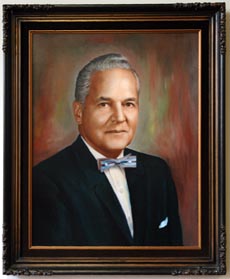 On May
1, Jay Asher transferred control of WJDA (1300 Quincy) and WESX
(1230 Salem) to new owner Otto Miller, who promptly flipped both
stations to a Spanish-language religious format. Knowing the
sale was imminent, we made it a point to visit both stations
- and to meet Jay - during a late-March visit to Boston.
On May
1, Jay Asher transferred control of WJDA (1300 Quincy) and WESX
(1230 Salem) to new owner Otto Miller, who promptly flipped both
stations to a Spanish-language religious format. Knowing the
sale was imminent, we made it a point to visit both stations
- and to meet Jay - during a late-March visit to Boston.
(The whole theme of the visit, unwittingly, turned out to be "Things That Won't Be Around Much Longer," as you'll see on the next few installments of our saga.)
WJDA, of course, is named for Jay Asher's father, James D. Asher, shown at left. (Jay's actually James D. Asher, Junior.) Asher, senior, put the station on the air September 11, 1947. Its current transmitter site, in a marshy area off Sea Street, went into service in the fifties. Back then, there was a road that led down here off the end of State Street. Today, after numerous coastal storms, the path to the tower is a walking trail, then a steep climb down the side of an embankment, followed by a walk across the marsh to the transmitter building, which sits on elevated piers above the marsh. (Yes, it floods here on a regular basis!)
It once took the entire building to house WJDA's 1000-watt transmitter; today, the BE solid-state AM1A transmitter that powers the station takes up just a little bit of the floor space in the building, and requires pretty much zero maintenance. (Originally a daytimer, WJDA now operates after dark with 72 watts, which covers Quincy and parts of several adjacent towns pretty well.)
It's only about a mile from the tower to the studio on Brackett Street, and that's where we head next.
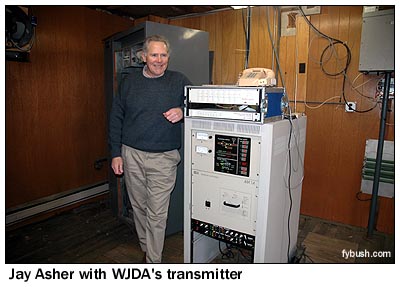 |
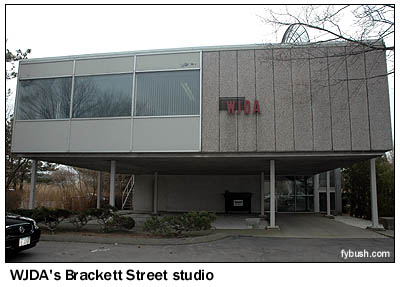
|
This building went up in the sixties, replacing an earlier studio building at the same location. The ground floor holds only the entryway and a small storage area; the rest of the station is up a flight of stairs, beginning in a lobby decorated with the painting (shown above) of Jim Asher and a beacon removed from the tower after the FAA determined it didn't need to be painted or lit. The two big windows in the lobby look into small production studios. At left is the main talk studio, which was filled during our visit with high-school culinary arts students being interviewed on the local talk show. And just down that hallway is WJDA's master control room, shown below at right.
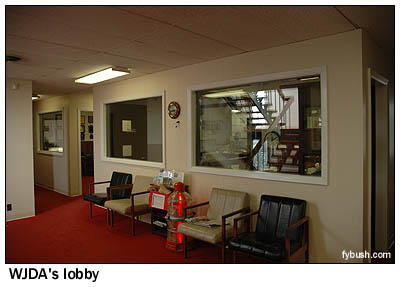 |
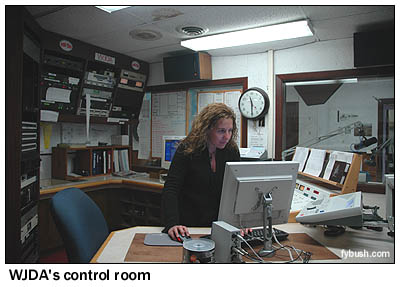 |
These kids probably don't listen to AM radio much, if at all - but after the show's over (leaving behind some very tasty-looking desserts), we hear a couple of of them on their cellphones in the lobby asking Mom and Dad "did you hear me on the radio"? That's what local radio is all about, and we're saddened to think that it won't be around much longer.
Toward the front end of the building, we see several offices, including Jay's. At the other end of the building, a newsroom looks into master control, and beyond that are a small kitchen area and a few more offices, including one that houses what's left of WJDA's music library. (The music heard on WJDA in recent years came from ABC's "Memories" service, which is itself going out of business shortly.)
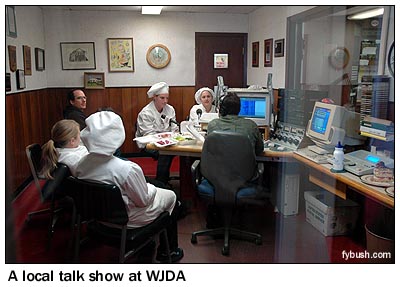 |
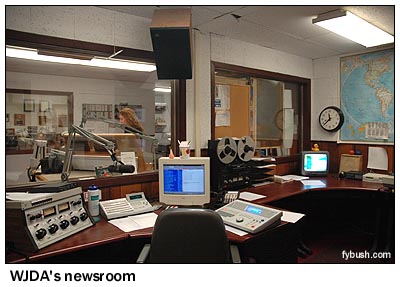 |
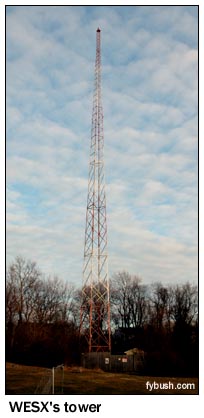 After
a pleasant lunch with Jay and Boston radio history guru Donna
Halper, our little band of tower folks (which on this day includes
Garrett Wollman of the Archives
@ BostonRadio.org and Mike Fitzpatrick of NECRAT.com)
is off for more adventures (which you'll see here next week),
ending up at day's end at WJDA's North Shore sister station,
WESX (1230).
After
a pleasant lunch with Jay and Boston radio history guru Donna
Halper, our little band of tower folks (which on this day includes
Garrett Wollman of the Archives
@ BostonRadio.org and Mike Fitzpatrick of NECRAT.com)
is off for more adventures (which you'll see here next week),
ending up at day's end at WJDA's North Shore sister station,
WESX (1230).
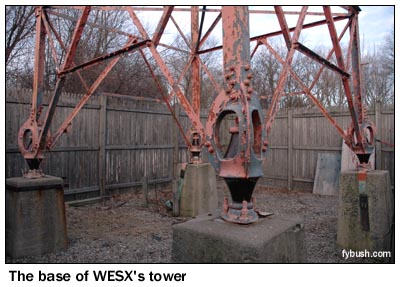 WESX
signed on in December of 1939, operating at 1200 on the dial
for just a couple of years before the NARBA shifts of 1941 moved
the station to 1230. (The calls stand for ESseX County.)
WESX
signed on in December of 1939, operating at 1200 on the dial
for just a couple of years before the NARBA shifts of 1941 moved
the station to 1230. (The calls stand for ESseX County.)
The station's studios were originally on Washington Street in Salem, but the transmitter has always been over in Marblehead, on Naugus Avenue at the extreme northeastern corner of the little peninsula town. It's a great location, with a saltwater path that ends up carrying the signal down to the South Shore surprisingly well.
Asher bought the station in 1950, and a few years later moved the station's studios out here to Marblehead as well. Eventually, the transmitter moved out of the little Cape-style building at the site, relocating to a little building right next to the tower. Today, WESX's kilowatt of power comes from a BE transmitter that's a twin to the one at WJDA. (Look carefully on the shelves and you'll see a third BE transmitter that can be used as a backup at either station.)
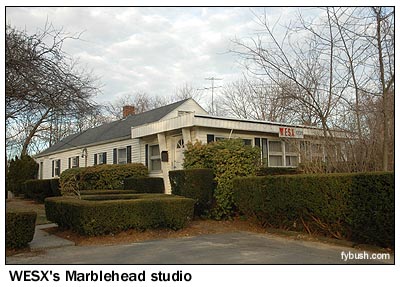 |
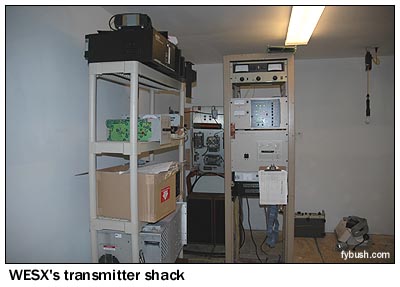 |
The plan here was for us to get a quick peek at the studios in the company of Betty Stavis, a WESX institution of many years, but alas, Betty's gone for the day by the time we're done fighting traffic to get up to Marblehead from Boston. So after getting some shots of the exterior of the building and the transmitter (it's a rare self-guided transmitter tour, thanks to a key that Betty's left behind), we decide to return the following Monday morning to see the inside of the studio building.
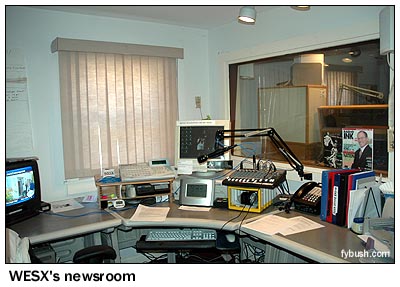 |
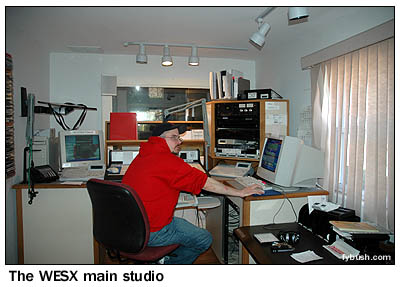 |
WESX's studios are - were? - small but functional, with a row of studios (talk, newsroom, master control) arranged along the front of the building and a row of offices along the back.
Alas, these facilities, along with the studios at WJDA, breathed their last on April 30. The new format on WESX and WJDA comes from a new studio plant in Chelsea. We certainly can't begrudge Jay and his family for cashing out after quite literally a lifetime operating these stations. Nor can we begrudge the new owners for doing what they have to do to pay the bills. ("You can't run stations like these if you're carrying debt," says Asher of his locally-focused programming.) It's also true that in recent years, the programming on WESX and WJDA was a far cry from the stations' heydays, with many hours filled with satellite-delivered music and brokered shows.
And yet - now that the local programming on these stations is gone for good, will those culinary arts students ever get to appear on the radio again? Who'll talk about Swampscott high school football, or the Braintree selectmen?
Next week - more soon-to-vanish bits of Boston-area radio history...
- Previous Site of the Week: The Minnesota/Wisconsin Big Trip, part XII: La Crosse, Wisconsin
- Next Week: WFNX, Lynn, Massachusetts: Transmitter Sites, New and Old (And Studios, Too)
- Site of the Week INDEX
- How can you help support Site of the Week? Click here!
- Submit your suggestions for a future Site of the Week!
